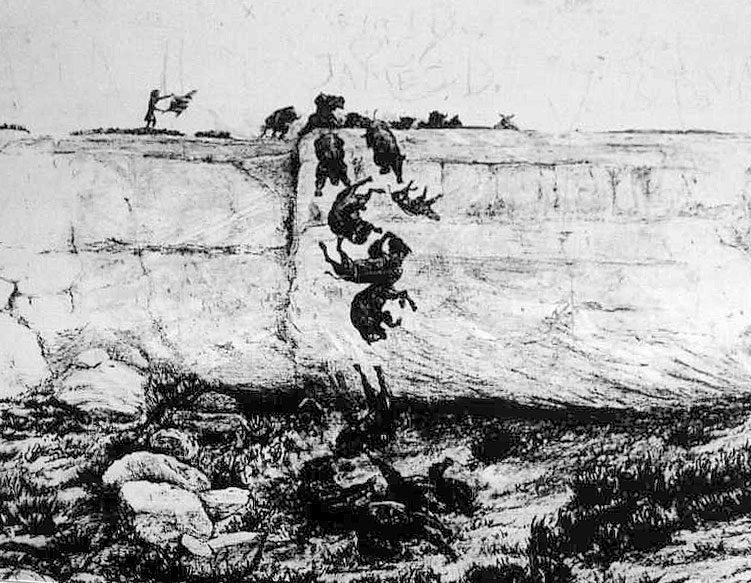Game drive system on:
[Wikipedia]
[Google]
[Amazon]
 The game drive system is a hunting strategy in which game are herded into confined or dangerous places where they can be more easily killed. It can also be used for animal capture as well as for hunting, such as for capturing
The game drive system is a hunting strategy in which game are herded into confined or dangerous places where they can be more easily killed. It can also be used for animal capture as well as for hunting, such as for capturing

A Buffalo Jump
, Discovering Lewis and Clark, The Lewis and Clark Fort Mandan Foundation
mustang
The mustang is a free-roaming horse of the Western United States, descended from horses brought to the Americas by the Spanish. Mustangs are often referred to as wild horses, but because they are descended from once-domesticated animals, th ...
s. The use of the strategy dates back into prehistory. Once a site is identified or manipulated to be used as a game drive site, it may be repeatedly used over many years.
Game drives
In theRocky Mountain National Park
Rocky Mountain National Park is an American national park located approximately northwest of Denver in north-central Colorado, within the Front Range of the Rocky Mountains. The park is situated between the towns of Estes Park to the east and ...
, for instance, there are archeological remains from about 3,850 and 3,400 B.C. of 42 low-walled stone structures or cairns, up to hundreds of feet in length, built for game drive systems. These slight walls served as devices that permitted hunters to direct or herd game animals—like bison, sheep, deer, or elk—toward men waiting with weapons. Up to twenty-five people may have been needed to execute the game drive. Hunters may have killed the animals using darts, atlatl
A spear-thrower, spear-throwing lever or ''atlatl'' (pronounced or ; Nahuatl ''ahtlatl'' ) is a tool that uses leverage to achieve greater velocity in dart or javelin-throwing, and includes a bearing surface which allows the user to store en ...
, spear throwers, or spears tipped with stone projectile points.
The Jones-Miller Bison Kill Site
The Jones-Miller Bison Kill Site, located in northeast Colorado, was a Paleo-Indian site where Bison antiquus were killed using a game drive system and butchered. Hell Gap complex bones and tools artifacts at the site are carbon dated from abou ...
is an example of how the terrain was used about 8,000 B.C. as a game drive site. Remains of 300 bison were found in an arroyo, or draw
Draw, drawing, draws, or drawn may refer to:
Common uses
* Draw (terrain), a terrain feature formed by two parallel ridges or spurs with low ground in between them
* Drawing (manufacturing), a process where metal, glass, or plastic or anything ...
, above the Arikaree River
The Arikaree River is a river in the central Great Plains of North America. It lies mostly in the American state of Colorado, draining land between the North and South Forks of the Republican River, and it flows into the North Fork in Nebraska ...
basin. It was believed that the bison were strategically driven into an area difficult for the bison to traverse and easier to kill on three occasions. Because many of the animals were nursing calves, it is estimated that the kills occurred in late fall or winter.''Folsom Traditions 9,000 - 8,000 BC.'' Waldo Rudolph Wendel said in 1986 that it was the "most carefully studied bison kill" site.

Buffalo jump
Abuffalo jump
A buffalo jump, or sometimes bison jump, is a cliff formation which Indigenous peoples of North America historically used to hunt and kill plains bison in mass quantities. The broader term game jump refers to a man-made jump or cliff used for hun ...
is an example of a game drive system. Hunters herded the bison
Bison are large bovines in the genus ''Bison'' (Greek: "wild ox" (bison)) within the tribe Bovini. Two extant taxon, extant and numerous extinction, extinct species are recognised.
Of the two surviving species, the American bison, ''B. bison'' ...
and drove them over the cliff, breaking their legs and rendering them immobile. Tribe members waiting below closed in with spears and bows to finish the kills. The Blackfoot
The Blackfoot Confederacy, ''Niitsitapi'' or ''Siksikaitsitapi'' (ᖹᐟᒧᐧᒣᑯ, meaning "the people" or " Blackfoot-speaking real people"), is a historic collective name for linguistically related groups that make up the Blackfoot or Bla ...
Indians called the buffalo jumps "pishkun", which loosely translates as "deep blood kettle". This type of hunting was a communal event which occurred as early as 12,000 years ago and lasted until at least 1500 AD, around the time of the introduction of horses. The broader term game
A game is a structured form of play, usually undertaken for entertainment or fun, and sometimes used as an educational tool. Many games are also considered to be work (such as professional players of spectator sports or games) or art (suc ...
jumps includes buffalo jumps and cliffs used for similarly hunting other herding animals, such as reindeer. The Indians believed that if any buffalo escaped these killings then the rest of the buffalos would learn to avoid humans, which would make hunting even harder., Discovering Lewis and Clark, The Lewis and Clark Fort Mandan Foundation
References
{{Prehistoric technology Bison hunting Hunting in the United States Hunting in Canada First Nations culture Paleo-Indian period Native American hunters Hunting